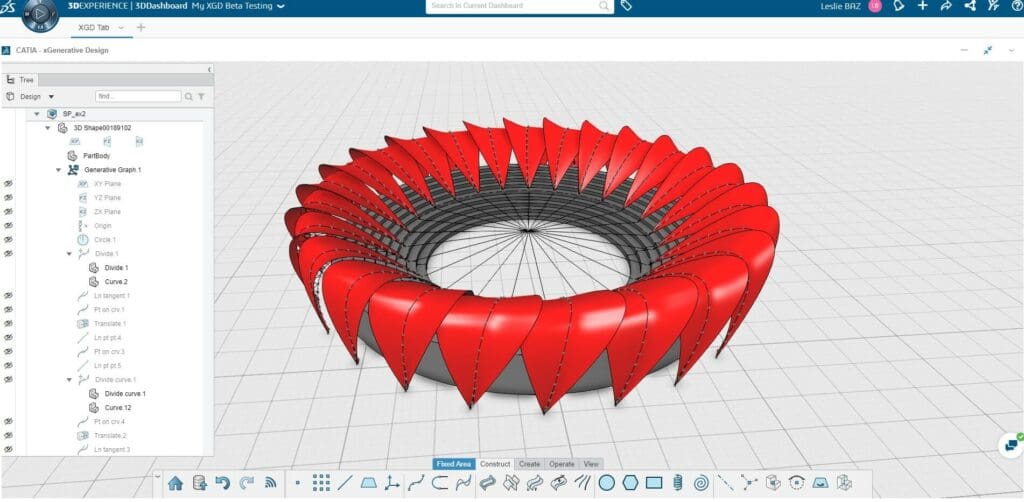
Gehry’s CATIA in the Age of Computational Design
How On Earth Would You Build That?
When the Canadian-born American architect Frank Gehry designed Peix—the fish-shaped sculpture commissioned for Barcelona when it hosted the 1992 Olympics—his team had to figure out how to build it.
As explained by researcher and analyst Lian Chan in Priceonomics, the ‘resident hippie’ at Gehry’s practice named Jim Glymph suggested using CATIA, Dassault’s software originally developed to design fighter jets. The project’s results were a hit, and Gehry’s practice used, built over it, and set the foundation for CATIA in the AEC industry.
“Gehry suspected that digitally designed geometries could be executed much more efficiently with less redundancy,” Chan wrote. “Instead of creating standard 2D construction drawings, Gehry now had his contractors refer directly to the 3D digital model, translating digitized coordinates directly into manual cutting instructions and machine tooling paths.”
Lian Chan, Priceonomics
With Peix and soon after, the Disney Concert Hall in Los Angeles, came the birth of BIM and Digital Design and Construction.
xGenerative Design: A Gateway into CATIA
A foundational challenge with CATIA is that it was originally built for mainframes and large legacy manufacturing companies such as Boeing and Toyota. This has worked magnificently well when multiple versions of widgets needed to be made, but for users in AEC, where every construction project is unique and the supply chain extremely fragmented, this has created a huge learning curve that few in the AEC industry have been willing to invest in.
Enter xGenerative Design, a new application built on Dassault’s Systemes Convergence Geometric Modeler (CGM) the same kernel utilized by CATIA. The new app focuses on generative design and delivering on the production of complex geometry; it has been developed to be accessible and intuitive for those new to the concept of generative design. As the Computational BIM Specialist at VIATechnik, I was tasked with learning how to use xGenerative Design, and after a four hour workshop, I found myself quite comfortable with it! Here’s a breakdown of what I learned (or scroll down to see a table comparison of xGenerative Design versus the most popular visual programming software out there.
xGenerative Design, a Web-based Visual Programming App
xGenerative Design is a mix of Grasshopper and Dynamo, taking the strongest features of both while running on a cloud server. Much of xGenerative Design’s development is inspired by Grasshopper, which by observation still leads the market for Generative Design. Similar to Grasshopper, a user can start to build a design from points inside a 3D viewport— in this case though, the 3D viewport lives inside your browser! And get this: simultaneously, the generative graph starts to automatically build up, a notable difference from Grasshopper in that users have to manually add basic components and select the 3D objects that the components reference from. And as with Dynamo, xGenerative Design has strong parameter editing capabilities that create fabrication level models and drawings much more expediently.
Moreover, xGenerative Design’s user interface allows for clicking directly on objects in the 3D viewport and making edits without going into the generative graph. Also, upon creating a new project, basic nodes such as reference planes and origin points are pre-populated, making it significantly quicker to start designing. Not to mention that there are several useful node layout options, such as distinguishing inputs from outputs in the graph, which helps to clean up a design sequence.
As I mentioned earlier, xGenerative Design is web-based (think Flux), making data and file management much more convenient, and virtually eliminating the use of files. xGenerative Design is part of a larger platform, so sharing models becomes a much easier task as well, with customizable Dashboards where data and model exchange between users can easily happen. Collaboration is highly marked here, a mighty torch to carry in the AEC industry. And let’s not forget, xGenerative Design makes use of the geometric kernel of CATIA, one of the most powerful engines in the market— after all, Frank Gehry did choose to digitize his designs on this platform.

Will xGenerative Design make a dent in the dominance of Grasshopper and Dynamo? The jury is still out there, but we are excited about the opportunity of mixing CATIA’s digital manufacturing expertise with the craziness of AEC design-build processes. If you’d like to learn more or schedule a demo, please feel free to reach out!
Full Disclaimer: VIATechnik has recently partnered with Dassault Systemes to explore opportunities in getting digital manufacturing workflows into design and construction.



